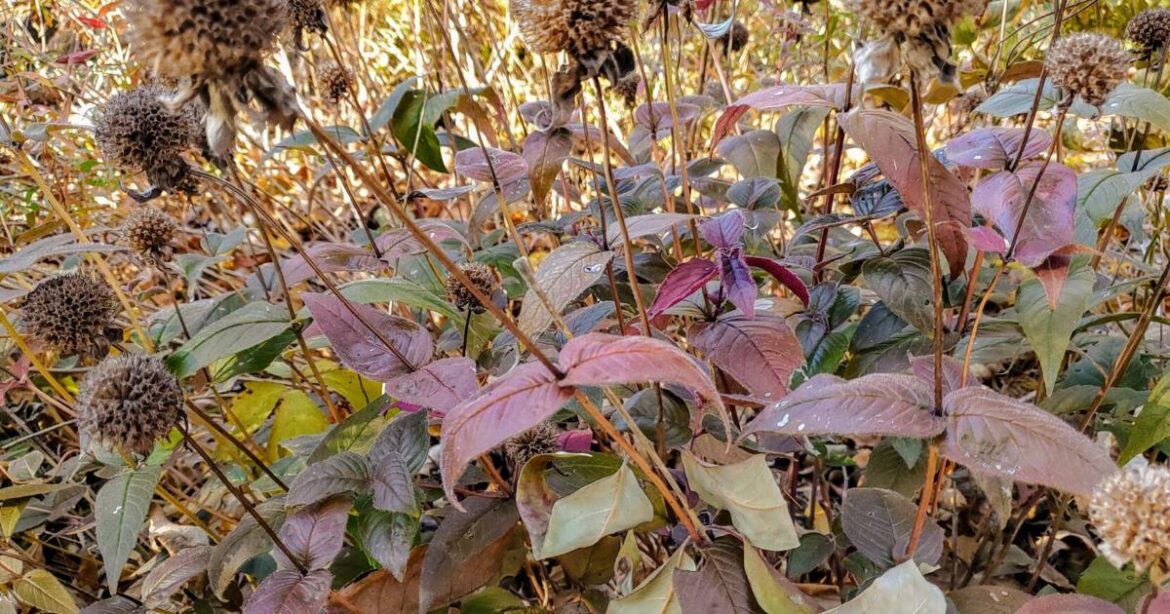With colder weather approaching, especially at night, the garden’s transition to winter has sped up in the last week or so. Earlier this week, I was out in the garden taking in the fall colors and looking at what plants still have something going on. Here’s a short list of some of the standouts in my own gardens.
Aromatic aster (Symphyotrichum oblongifolium)
Aromatic aster is still blooming across my pollinator garden. I’ve often observed this plant flowering as late as Thanksgiving, and you can bet pollinators will be present on warmer sunny days. At a time when relatively nothing else has flowers, this plant is a standout.
In the early days of our front yard pollinator gardens (circa 2018), as we transitioned our yard from the turf that covered it for over 60 years to a diverse pollinator garden, I really appreciated this plant. It quickly established and grew to a sizable spread in a single growing season. In addition, it swiftly produced plenty of transplants for further expansion of our pollinator beds over time.
However, that fast establishment and spread really speak to the nature of the aster family. Many of these plants can be aggressive and become problematic. While many gardeners may loathe asters, it’s hard to deny their stellar fall blooms. With aromatic asters’ late-season performance each year, it has become a mainstay of our front-yard gardens. Maintaining asters in harmony with other plants is simply an exercise in the age-old adage, “Right place for the right plant.”
When arranging asters or other aggressive plants in the garden, consider using natural barriers to limit spread, such as sidewalks, bed edges or transitions. The physical barrier these features create works to limit spread in at least one direction, helping you to focus control efforts on other directions. I’ve also successfully used other semi-aggressive species as companion plants to limit spread in their direction.
Prairie coreopsis (Coreopsis palmata)
Prairie coreopsis was a bit of a surprise performer this fall. In the last few weeks, as it’s started to senesce, my plants have developed excellent fall color. The tall, spindly stems and thin, feathery leaves have all turned a spectacular red color, which is now gently fading to yellow. It seems like most years this plant puts out an impressive fall display, but in some years, it just doesn’t. I’m not sure what factors may be at play, although I am certain the current drought is impacting fall transition for many plants. Perhaps the overly colorful display this year is a sign of stress?
Beyond fall color, prairie coreopsis has a lot to offer in the garden, with a long season of blooms (often May to July) that are a pollinator favorite. The open, composite-style flower is attractive to nearly every group of pollinating insects. In addition, this plant is host to several native moth species
Prairie coreopsis is another potentially aggressive neighbor in the garden, making it a nice companion plant to aromatic aster. I take a similar strategy with this plant as with asters, by planting it in spaces with limited spread due to hardscaping or other features. Its most aggressive spread is from rhizomes, which can often be easily limited by physical barriers, like sidewalks or driveways. In addition, this adaptable plant may be drastically cut back during the growing season to limit height or size, or it can be actively deadheaded to promote flowering.
Bradbury’s beebalm (Monarda bradburiana)
Bradbury’s beebalm is becoming one of my new favorite plants! For years, I’d observed it in other gardens but never had plants of my own until two summers ago. Right now, this plant has outstanding fall color in my garden, with semi-green leaves fading to a nice burgundy red or purple color.
Over the next few weeks, its purple-red color will intensify until slowly fading to brown by mid-winter. Its chunky, coarse flower heads and brown leaves hang on into winter, providing some nice structural interest in the coming months.
In addition to its fall delight, this plant hosts a spectacular flower in very early summer, which is a somewhat rare bloom time among monarda species. Its purple, spotted petals, along with an interesting, tubular flower shape, are unlike any other native flower and, by far, my favorite monarda flower.
Bradbury’s beebalm is a clump-forming, non-aggressive plant that remains small in size and stays well-behaved. It works perfectly at the edges of beds or in between other plants, with better shade tolerance than most beebalms.
Ryan Pankau is horticulture extension educator with University of Illinois Extension serving Champaign, Ford, Iroquois and Vermilion counties.


Comments are closed.